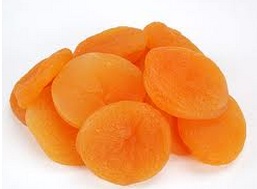Selection of apricot fruits.
 Choose the Apricots from the farms and ensure to choose firm, mature, deep orange apricots and dry them soon after harvesting. Wash the apricot by spraying it with white vinegar and rinsing well. Remove any bad spots from the apricot.
Choose the Apricots from the farms and ensure to choose firm, mature, deep orange apricots and dry them soon after harvesting. Wash the apricot by spraying it with white vinegar and rinsing well. Remove any bad spots from the apricot.Cut the Apricots Cut each apricot in half. Remove the pit. Press the skin of the apricot inward pushing the flesh of the apricot outward. This is called popping the back of the apricot and it aids in the drying process.
Dip the Apricots Apricots should be dipped prior to drying to prevent oxidation. Oxidation is the browning of apricots when exposed to air. Oxidation causes apricots to lose some vitamin content. Dipping in lemon, or lime, juice is the most natural method of preventing oxidation. To dip apricots, cover the apricot slices in water with added lemon or lime juice for 5 minutes prior to drying them. You will need 1/4 cup of juice for every cup of water needed to cover the apricots.
Prepare for Drying Spread the apricots in a single layer. The apricots should be spread evenly and not allowed to overlap one another, as air should circulate freely between each piece of fruit. A glass dish is perfect for oven, or air, drying. If you are using a food dehydrator, layer the apricots evenly on the trays.
Choose a Dehydration, or Drying, Method There are 3 general methods of dehydration: Sun (air) drying, oven drying, and food dehydrator. Each has its advantages and disadvantages.
(1) Sun or Air Drying -
Sun, or air drying, is the most natural form of dehydration. It requires a warm day with temperatures near 100 degrees and low humidity. To sun dry apricots, place apricots in a sunny window. A car window can provide an ideal place for sun drying as the ideal temperature for drying apricots is 135 degrees.
(2) Oven Drying -
If your oven maintains low temperatures, between 120 and 150 degrees, oven drying is a good choice for occasional use. It does not require the purchase of special equipment and is reliable when the weather isn't sufficient for dehydration. To oven dry apricots, place them in the oven and set the oven to 135 degrees.
(3) Food Dehydrator -
A food dehydrator consumes less energy than an oven and is the preferred method of dehydration for regular use. If you dry a lot of food, and the weather in your area isn't ideal for sun drying, a food dehydrator is a consistent, low energy, dehydration method. Layer the apricots on the drying trays and dry apricots according to the manufacturers instructions.
Test for Dryness Apricots should have most of the moisture removed, but still be pliable. If they are crisp, they are too dry. Overly dried apricots work well for making apricot powder.
Storage of Dried Apricot Pack apricots in a moisture proof container such as a canning jar, or a sealed plastic container. Vacuum packing dried apricots will further prolong their shelf life, but storage in a glass, moisture proof container, is the most natural method. Label the apricots with the date of preservation. Store in a cool dry place. Dried apricots can be stored up to 12 months.
By,
M Anem,
Melaka City,
Melaka,
Malaysia
(28 Rabiulawal 1434)





No comments:
Post a Comment